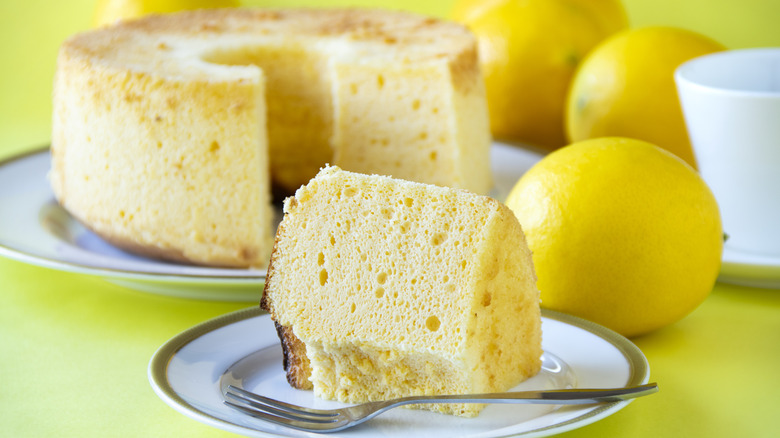The Common Mistake To Avoid For Your Chiffon Cake To Perfectly Rise
Chiffon cake, gracefully named after a light and flowing fabric, is a wondrous spectacle to behold. Before it's cut into slices, a chiffon cake's golden exterior looks similar to a sponge cake. Yet when this cake is sliced, the springy, airy interior is revealed, much lighter than that of most other cakes. Whether it's flavored with earthy matcha, tart lemon, or silky vanilla, the quintessential characteristic of this cake is its high and airy rise.
If you've struggled to achieve the perfect height with your chiffon cake, resulting in a flat and dense dessert, a common oversight is applying butter or oil to the tin before baking. It may sound strange to skip this step, but an ungreased tube pan helps the chiffon cake to ascend while baking and minimizes the risk of collapse after it's removed from the oven. Using a pan without grease or flour enables the cake batter to crawl up the pan's sides, creating an tall rise.
Chiffon cake also needs to be inverted, i.e. the whole pan, cake included, needs to be flipped upside-down as soon as it exits the oven. Inverting the cake keeps it from collapsing and aids in the perfect rise. An ungreased baking pan ensures that the cake doesn't fall out when you flip it over, and that extra stickiness keeps the cake intact throughout the whole upside-down cooling process, so the crumb can properly expand and end up fluffy and light.
It's all about gravity
When you bake a cake and cool it, gravity is a factor in determining its height and texture. While cakes made with denser and sturdier batters can hold their form against gravity, delicate chiffon cakes require a touch more assistance. If cooled right-side-up, gravity will gradually squish the delicate cake downward, making it dense.
During the baking process, when baking powder interacts with a liquid in a recipe, it triggers a chemical reaction that generates carbon dioxide. This gas, in turn, forms air bubbles within the cake. The many bubbles inside the chiffon cake are created by whisking and aerating the egg whites in the batter, then combining them with baking powder and heat. In the oven, these air bubbles enlarge, but once the cake is removed, the air pockets start to shrink. Keeping the pockets' shrinkage to a minimum is vital to achieving a light, airy, tall cake, which means you need to work against gravity.
Using an ungreased pan and inverting the cake over a cooling rack means that gravity will push on the bottom of the cake rather than the top, expanding the cake and making it "rise," even though it's upside-down. By not greasing the pan, the cake batter is able to take hold of the sides as it bakes, helping it rise, and then as it cools, it won't fall out. Not greasing the pan makes your cake better and won't leave you with greasy fingers, making it a double victory.
Other ways to ensure a good rise
While not greasing your pan makes for a better texture, you will have to take a knife or a spatula to the edges of the cake to unmold it, which can result in a messy look when it releases from the pan. If you're not quite a pro at unmolding cakes, any messy edges can easily be concealed with a light coating of frosting,
Your choice of baking pan will also impact the rise of your chiffon cake. Ideally, you want to use a tube pan, as the hollow center allows heat to permeate the cake's core and pull off a more even baking job. Avoid using a Bundt pan, as the deep grooves risk compromising the fragile edges of the cake. It's best to use a smooth-sided tube pan made just for chiffon and angel food cake.
One last tip for the best chiffon cake texture is to pay attention to the egg whites. Chiffon cakes partly owe their delicate nature to the higher proportion of eggs compared to flour; as such, the eggs need to compensate for some of the structure usually provided by flour. To achieve a cloud-like rise, beating the eggs into a meringue is a must, but if the egg whites are beaten until they form stiff peaks, the cake will turn out dry. The sweet spot lies between stiff and medium peaks, with a nudge towards the firmer end.


